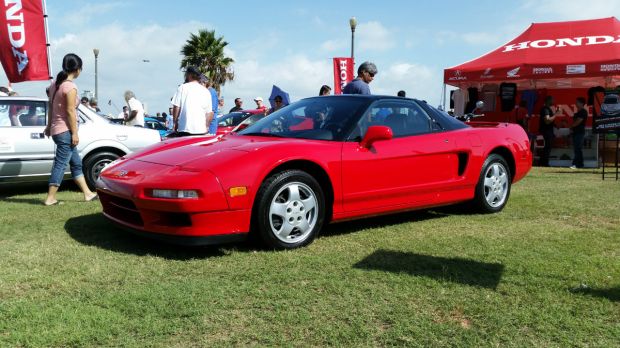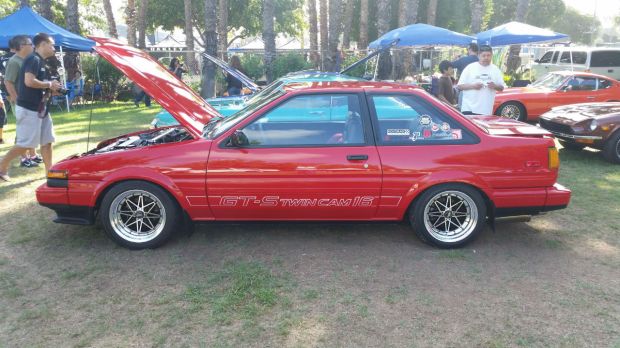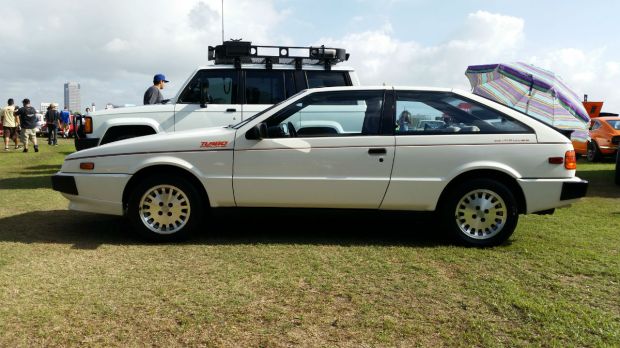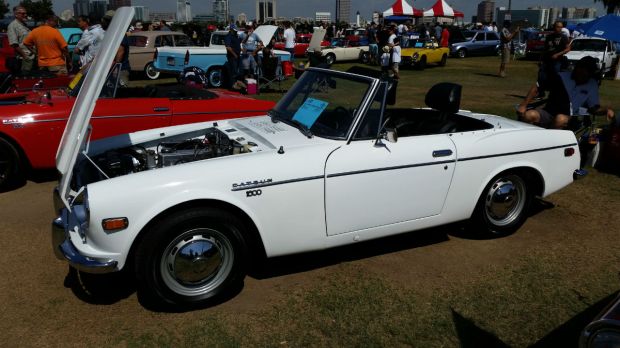 Over the last few years, we’ve been delighted to observe a gradual shift toward mainstream acceptance in America of older Japanese automobiles as collectible classics. The Carriage House fleet has in recent times included first-generation examples of the Mazda Miata and Toyota MR2, so we’re well acquainted with the sporting virtues of lightweight, solidly built “J-tin,” and we’re happy that more and more people are rejecting the antiquated viewpoint that Japanese cars are nothing but soulless appliances. So when our old friend Ben Hsu, founder and editor-in-chief of Japanese Nostalgic Car, expressed to us his desire to create an American touring rally for vintage Japanese cars (the sort of event to which owners of more widely recognized classics from Europe and the U.S. have had access for years) we jumped at the chance to help bring his vision to life.
Over the last few years, we’ve been delighted to observe a gradual shift toward mainstream acceptance in America of older Japanese automobiles as collectible classics. The Carriage House fleet has in recent times included first-generation examples of the Mazda Miata and Toyota MR2, so we’re well acquainted with the sporting virtues of lightweight, solidly built “J-tin,” and we’re happy that more and more people are rejecting the antiquated viewpoint that Japanese cars are nothing but soulless appliances. So when our old friend Ben Hsu, founder and editor-in-chief of Japanese Nostalgic Car, expressed to us his desire to create an American touring rally for vintage Japanese cars (the sort of event to which owners of more widely recognized classics from Europe and the U.S. have had access for years) we jumped at the chance to help bring his vision to life.
 Ben’s belief in the viability of such an event was bolstered by the recent success of Japanese classics at high-profile collector car auctions, such as several sales of the much sought-after Toyota 2000GT for over $1 million, or excellent examples of the Nissan Skyline “hakosuka” and Mazda Cosmo Sport (pictured at top and above, respectively) cracking the quarter-million dollar mark. Additionally, publications ranging from Hemmings Motor News to the New York Times have indentified Japanese cars as a future growth area in the collector car world, and suddenly everyone seems to want a piece of the action. Always having been ahead of this curve, Ben felt that the time was right to give Japanese classics the vintage rally treatment as a way to spotlight not only the beauty of these amazing machines, but also their usability as “event cars.”
Ben’s belief in the viability of such an event was bolstered by the recent success of Japanese classics at high-profile collector car auctions, such as several sales of the much sought-after Toyota 2000GT for over $1 million, or excellent examples of the Nissan Skyline “hakosuka” and Mazda Cosmo Sport (pictured at top and above, respectively) cracking the quarter-million dollar mark. Additionally, publications ranging from Hemmings Motor News to the New York Times have indentified Japanese cars as a future growth area in the collector car world, and suddenly everyone seems to want a piece of the action. Always having been ahead of this curve, Ben felt that the time was right to give Japanese classics the vintage rally treatment as a way to spotlight not only the beauty of these amazing machines, but also their usability as “event cars.”
 So, how does Carriage House Models fit into all of this? Well, it turns out that our relationship with Ben Hsu dates back to the late 1980s, when as car-crazy middle-schoolers, our founder bonded with Ben over a shared love of diecast models. Household moves, college and careers in different parts of the country separated us for a couple of decades, during which time the Carriage House team got heavily involved in the Southern California road rally scene, first competing in, and then organizing a number of TSD navigational rallies in the L.A. area. Several years ago we rekindled our friendship with Ben thanks to a Facebook-facilitated reunion, and when the time came for him to make his Japanese classic car rally dream a reality, we were delighted to offer our experience in road rally organization to the cause. (Pictured above: the dear departed Carriage House MR2, used extensively in early research for this event.)
So, how does Carriage House Models fit into all of this? Well, it turns out that our relationship with Ben Hsu dates back to the late 1980s, when as car-crazy middle-schoolers, our founder bonded with Ben over a shared love of diecast models. Household moves, college and careers in different parts of the country separated us for a couple of decades, during which time the Carriage House team got heavily involved in the Southern California road rally scene, first competing in, and then organizing a number of TSD navigational rallies in the L.A. area. Several years ago we rekindled our friendship with Ben thanks to a Facebook-facilitated reunion, and when the time came for him to make his Japanese classic car rally dream a reality, we were delighted to offer our experience in road rally organization to the cause. (Pictured above: the dear departed Carriage House MR2, used extensively in early research for this event.)
 Over the course of eighteen months, we worked with Ben to create exactly the sort of event he envisioned: a fun-to-drive, non-competitive tour of scenic, challenging roads that would not only give owners of classic Japanese cars a chance to enjoy them in the manner for which they were intended, but also would allow these same cars to be photographed and promoted in the most beautiful scenery imaginable. Ben laid out a few specifications (start and finish locations, time and distance parameters, etc.) but otherwise gave us nearly carte blanche to write the route. We responded by crafting a 120-mile course through our beloved Santa Monica Mountains that would be both thrilling to drive and gorgeous to behold. As it drew upon the Japanese tradition of spirited mountain-pass driving known as touge for inspiration, it seemed only natural to call the new event “Touge California.” From the moment the words were first uttered, we knew we were onto something special.
Over the course of eighteen months, we worked with Ben to create exactly the sort of event he envisioned: a fun-to-drive, non-competitive tour of scenic, challenging roads that would not only give owners of classic Japanese cars a chance to enjoy them in the manner for which they were intended, but also would allow these same cars to be photographed and promoted in the most beautiful scenery imaginable. Ben laid out a few specifications (start and finish locations, time and distance parameters, etc.) but otherwise gave us nearly carte blanche to write the route. We responded by crafting a 120-mile course through our beloved Santa Monica Mountains that would be both thrilling to drive and gorgeous to behold. As it drew upon the Japanese tradition of spirited mountain-pass driving known as touge for inspiration, it seemed only natural to call the new event “Touge California.” From the moment the words were first uttered, we knew we were onto something special.
 We soon found that we were not alone. Ben reached out to his vast network of contacts in the Japanese car world to find partners in making Touge California more than just a cruise in the countryside. The response was overwhelming: heavyweights including Toyota, Yokohama Tire, Koyorad Radiator, Mattel, and Mother’s Car Care jumped at the chance to sponsor this groundbreaking event. Toyota was especially game, granting us use of facilities and vehicles before and during the rally (including an incredibly well-appointed Sienna SE minivan, which would serve as a shuttle for members of the press who came along to report on the event.)
We soon found that we were not alone. Ben reached out to his vast network of contacts in the Japanese car world to find partners in making Touge California more than just a cruise in the countryside. The response was overwhelming: heavyweights including Toyota, Yokohama Tire, Koyorad Radiator, Mattel, and Mother’s Car Care jumped at the chance to sponsor this groundbreaking event. Toyota was especially game, granting us use of facilities and vehicles before and during the rally (including an incredibly well-appointed Sienna SE minivan, which would serve as a shuttle for members of the press who came along to report on the event.)
 After a flurry of last-minute preparations were completed, Touge California was finally ready to roll on May 16, 2015. After lunch and a tour of Mike Malamut’s private auto collection in Thousand Oaks, California, sixteen brave teams set off for a day of adventure in the Santa Monica Mountains. The route would include five “Touge” stages which would feature especially challenging roadways. As several of the cars on hand were equipped with somewhat primitive braking and cooling systems, workaround routes were devised for drivers who were uncertain of their vehicles’ ability to handle these demanding parts of the course. However, only drivers who could prove that they successfully completed the entire route (including all five Touge stages) by returning still-sealed envelopes to us at the finish would receive a coveted “I SURVIVED TOUGE CALIFORNIA” sticker at the end of the rally. Would any accept the challenge?
After a flurry of last-minute preparations were completed, Touge California was finally ready to roll on May 16, 2015. After lunch and a tour of Mike Malamut’s private auto collection in Thousand Oaks, California, sixteen brave teams set off for a day of adventure in the Santa Monica Mountains. The route would include five “Touge” stages which would feature especially challenging roadways. As several of the cars on hand were equipped with somewhat primitive braking and cooling systems, workaround routes were devised for drivers who were uncertain of their vehicles’ ability to handle these demanding parts of the course. However, only drivers who could prove that they successfully completed the entire route (including all five Touge stages) by returning still-sealed envelopes to us at the finish would receive a coveted “I SURVIVED TOUGE CALIFORNIA” sticker at the end of the rally. Would any accept the challenge?
 The first leg of Touge California 2015 headed west along the famed Mulholland Highway, followed by the first Touge stage of the event: a quick, downhill blast toward Westlake Village. The first checkpoint followed soon after in a lovely, pastoral setting. At that point, the consensus among the drivers was that if the remainder of the day was to be as exciting as the first part, Touge California was going to be a winner. (Pictured above: Sebastian Hill’s sensational Datsun 510 leads a small group of rallyists into Checkpoint 1.)
The first leg of Touge California 2015 headed west along the famed Mulholland Highway, followed by the first Touge stage of the event: a quick, downhill blast toward Westlake Village. The first checkpoint followed soon after in a lovely, pastoral setting. At that point, the consensus among the drivers was that if the remainder of the day was to be as exciting as the first part, Touge California was going to be a winner. (Pictured above: Sebastian Hill’s sensational Datsun 510 leads a small group of rallyists into Checkpoint 1.)
 The rally’s second leg took the drivers further west into the green farmlands south of Camarillo (after a brief second Touge stage full of second-gear switchbacks), ending at Point Mugu on Pacific Coast Highway. Here, all sixteen cars were brought together for a group photo, much to the surprise of unsuspecting onlookers (including a family of Japanese tourists who, quite serendipitously, happened to be at Point Mugu as part of their American vacation!) Taken as a collection, it was hard not to be impressed both with the diversity of cars assembled for the event, but also how comfortable they looked in these spectacular surroundings…they were, after all, BORN for just this sort of drive. Somehow, for far too long, America looked upon them as simple transportation devices, but Touge California seemed to unlock the soul within these cars, and the excitement among their owners was palpable. (Pictured above: the nearly identical Toyota Celica GTs of Mike Foertsch and Mike Malnick, complete with their original, highly sought-after California “blue plates.”)
The rally’s second leg took the drivers further west into the green farmlands south of Camarillo (after a brief second Touge stage full of second-gear switchbacks), ending at Point Mugu on Pacific Coast Highway. Here, all sixteen cars were brought together for a group photo, much to the surprise of unsuspecting onlookers (including a family of Japanese tourists who, quite serendipitously, happened to be at Point Mugu as part of their American vacation!) Taken as a collection, it was hard not to be impressed both with the diversity of cars assembled for the event, but also how comfortable they looked in these spectacular surroundings…they were, after all, BORN for just this sort of drive. Somehow, for far too long, America looked upon them as simple transportation devices, but Touge California seemed to unlock the soul within these cars, and the excitement among their owners was palpable. (Pictured above: the nearly identical Toyota Celica GTs of Mike Foertsch and Mike Malnick, complete with their original, highly sought-after California “blue plates.”)
 The second half of the day started with an easy drive south on PCH, before heading north on the most challenging Touge stage of the rally: a ten-mile hillclimb that snaked from Malibu to Agoura Hills and featured more than a few blind, decreasing-radius turns to keep the drivers on their toes. A workaround was offered, but all sixteen drivers courageously faced down the Touge…as they did with the fourth and fifth Touge stages. That’s right: EVERYONE completed the entire route, Touge stages and all, proving that Japanese reliability and driving exhilaration are far from mutually exclusive concepts. (Pictured above: Francis Jones’ Toyota TE27 Sprinter Trueno leads Jacob Brown’s first-generation Mazda Miata into Checkpoint 4, halfway through the final Touge stage.)
The second half of the day started with an easy drive south on PCH, before heading north on the most challenging Touge stage of the rally: a ten-mile hillclimb that snaked from Malibu to Agoura Hills and featured more than a few blind, decreasing-radius turns to keep the drivers on their toes. A workaround was offered, but all sixteen drivers courageously faced down the Touge…as they did with the fourth and fifth Touge stages. That’s right: EVERYONE completed the entire route, Touge stages and all, proving that Japanese reliability and driving exhilaration are far from mutually exclusive concepts. (Pictured above: Francis Jones’ Toyota TE27 Sprinter Trueno leads Jacob Brown’s first-generation Mazda Miata into Checkpoint 4, halfway through the final Touge stage.)
 The final portion of Touge California 2015 included a final drive south along PCH, followed by a surprisingly quick trip through Venice and Playa del Rey, before reaching the ultimate checkpoint at Dockweiler State Beach in El Segundo. Plans for sunset photography were scuppered by a long running time for the rally, so we departed as quickly as we had arrived for the post-rally festivities. Our friends at Toyota had arranged a Hawaiian buffet for our dinner at their American museum in Torrance, where Ben Hsu presented the coveted “I SURVIVED TOUGE CALIFORNIA” stickers to every driver.
The final portion of Touge California 2015 included a final drive south along PCH, followed by a surprisingly quick trip through Venice and Playa del Rey, before reaching the ultimate checkpoint at Dockweiler State Beach in El Segundo. Plans for sunset photography were scuppered by a long running time for the rally, so we departed as quickly as we had arrived for the post-rally festivities. Our friends at Toyota had arranged a Hawaiian buffet for our dinner at their American museum in Torrance, where Ben Hsu presented the coveted “I SURVIVED TOUGE CALIFORNIA” stickers to every driver.
 The day concluded with a tour of the Toyota museum led by Lexus executive Paul Williamsen, whose intimate knowledge of the cars on display made for an incredibly educational evening. For an event whose purpose was to celebrate the history of Japanese cars on American shores, a more fitting conclusion could not have been found.
The day concluded with a tour of the Toyota museum led by Lexus executive Paul Williamsen, whose intimate knowledge of the cars on display made for an incredibly educational evening. For an event whose purpose was to celebrate the history of Japanese cars on American shores, a more fitting conclusion could not have been found.
 Based on the response of the participants in the first-ever Touge California, both the drivers and our many sponsor partners, it’s almost certain that there will be more rallies to follow…the idea is to make Touge California an annual event, and we’re already in discussions with the Japanese Nostalgic Car team regarding potential routes and venues for next year! From the Carriage House Models perspective, our only regret was that we were so busy handling the logistics of the event (including driving the preview car) that we didn’t have much time to take a breath and enjoy sight of these beautiful classic cars tackling the roads we had selected for them. Thankfully, in addition to coverage from JNC itself, several other media outlets were on hand to record the proceedings. To read more (and to see some truly great photography from the route) visit Japanese Nostalgic Car, Petrolicious, or Revved.
Based on the response of the participants in the first-ever Touge California, both the drivers and our many sponsor partners, it’s almost certain that there will be more rallies to follow…the idea is to make Touge California an annual event, and we’re already in discussions with the Japanese Nostalgic Car team regarding potential routes and venues for next year! From the Carriage House Models perspective, our only regret was that we were so busy handling the logistics of the event (including driving the preview car) that we didn’t have much time to take a breath and enjoy sight of these beautiful classic cars tackling the roads we had selected for them. Thankfully, in addition to coverage from JNC itself, several other media outlets were on hand to record the proceedings. To read more (and to see some truly great photography from the route) visit Japanese Nostalgic Car, Petrolicious, or Revved.
Carriage House Models is beyond proud to have been part of the historic first running of Touge California, and we can’t wait to do it again next year!







